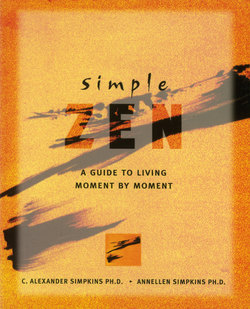Читать книгу Simple Zen - C.Alexander Simpkins - Страница 7
На сайте Литреса книга снята с продажи.
ОглавлениеINTRODUCTION
Zen Buddhism is a dynamic way to enhance living. Modern life demands our full attention, and there is often little time for anything else. The beauty of Zen is that it can help develop inner calm and better functioning even in the midst of a busy life. You do not have to make time for Zen—your Zen is with you all the time, enriching everything you do.
Zen points you back to your inner life, illuminating your true nature. As you become more adept at Zen meditation, it becomes integrated into your life, both at work and at play. “Not two!” the Zen masters would shout.
When we discovered Zen we were both graduate students, studying psychology and practicing martial arts. We delved deeply into the works of Suzuki, Dogen, Benoit, Watts, and other writers on Zen. We spent several years training our awareness in classes in New York City with Betty Keene and Charlotte Selver who conducted classes at the San Francisco Zen Center, and at the Tassahara Monastery. We spent long hours fully focusing our attention on the simplest of activities—breathing, sitting, standing whatever, to return our minds and bodies to natural functioning. We eagerly attended all the Zen lectures we could find, including those of Alan Watts. We continued to meditate as we searched for deeper understanding, discovering Zen through its many traditions, rather than narrowing to only one.
Zen gave us a perspective that opened new possibilities for psychology. In our studies in hypnosis with Milton Erickson, we saw a way of using Zen, that the unconscious was natural and intuitively intelligent. In fact it can be very wise. Our martial art, Tae Chun Do a form of moving meditation, continued to be a source of vitality and inner focus. We also took a Zen approach to the arts, specializing in wood crafting.
Just as we have been able to draw on Zen to enhance the quality of our lives, we hope that you, the reader, will find ways to make the most of Zen for yourself. There are many pathways into Zen, the capacity is already wired in. As the Zen masters say, “Nothing is missing.”
ABOUT SIMPLE ZEN
This book is designed to help you understand Zen. It is divided into three interrelated parts. Part I gives the background and development of Zen, illustrated with classic enigmatic stories of great Zen masters to set you on the Path. Time lines are included in the end of the book for quick reference. Part II explains key themes, pointing you in the right direction. Part III shows you how to bring the insights of Zen into your life, through the practice of meditation and Zen arts, just as Zen practitioners have done for centuries.
You may choose to apply relevant Zen concepts to help you improve your life, or you may decide to follow its path more deeply and comprehensively. Start with where you are. However you decide to integrate the Zen Way into your life, let it open your potentials and guide you to simply living fully, moment by moment.
HOW TO USE THIS BOOK
Meditate regularly. This is the basis for discovering Zen. Meditation helps you clear away extraneous chatter, to focus on what really matters. When your mind is clear, you will find it easier to concentrate on what you are doing. You will be able to meet life’s situations calmly and more energetically.
Zen is not just a set of concepts or a theory. It must be experienced. We encourage you to do the exercises. Read through the directions once or twice, then set the book aside and try them. When working with Zen arts, gather your materials first. Then set everything out and read through the directions before you begin. Concentrate on the quality of your mental attitude, not on the finished product or the goals. The journey is the essence of Zen: from an attuned, meditative awareness, you express yourself, your true self, at your best.
We invite you to enter the Path, and may you enjoy the journey!
